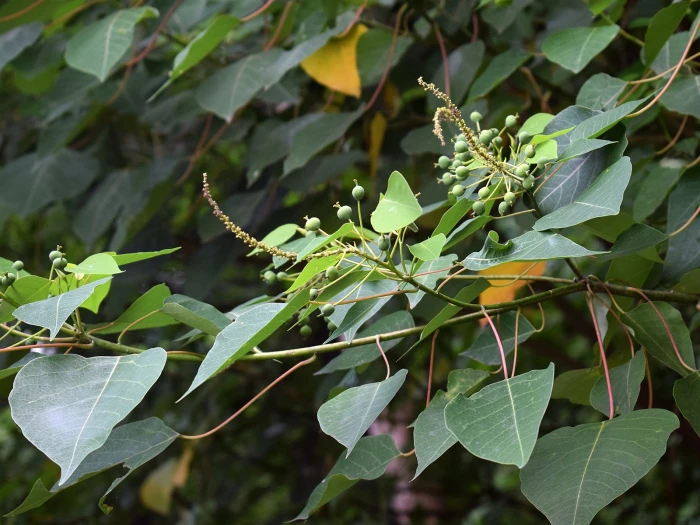Bleeding Heart Tree
(Homalanthus populneus)
Bleeding Heart Tree (Homalanthus populneus)
/
/

Wibowo Djatmiko (Wie146)
CC BY-SA 4.0
Image By:
Wibowo Djatmiko (Wie146)
Recorded By:
Copyright:
CC BY-SA 4.0
Copyright Notice:
Photo by: Wibowo Djatmiko (Wie146) | License Type: CC BY-SA 4.0 | License URL: http://creativecommons.org/publicdomain/zero/1.0/deed.en | Uploader: Wie146 | Publisher: Wikimedia Commons |







Estimated Native Range
Climate Requirements
| • Precipitation | 88" - 106" |
| • High Temp. | 75°F - 91°F |
| • Low Temp. | 57°F - 73°F |
Summary
Homalanthus populneus, commonly known as Bleeding Heart Tree or Queensland Poplar, is an evergreen or semi-deciduous tree native to rainforests and monsoon forests of the Pacific Islands. It typically grows to a height of 4-10 feet (1.2-3 meters) and a width of 6-15 feet (1.8-4.6 meters), with a spreading canopy that provides light shade. The tree is characterized by its heart-shaped leaves and small, inconspicuous greenish flowers followed by showy, bright red fruit that resemble a bleeding heart, hence the common name.
The Bleeding Heart Tree is valued for its attractive foliage and its unique fruit, which can add a splash of color to tropical and subtropical gardens. It is used in cultivation for ornamental purposes, as a feature plant in garden beds, and as a shade tree in parks. It is adaptable to a range of soil types, provided they are well-drained, and it can tolerate both full sun and part shade. While it has a relatively low water requirement once established, it benefits from regular watering during dry periods.CC BY-SA 4.0
The Bleeding Heart Tree is valued for its attractive foliage and its unique fruit, which can add a splash of color to tropical and subtropical gardens. It is used in cultivation for ornamental purposes, as a feature plant in garden beds, and as a shade tree in parks. It is adaptable to a range of soil types, provided they are well-drained, and it can tolerate both full sun and part shade. While it has a relatively low water requirement once established, it benefits from regular watering during dry periods.CC BY-SA 4.0
Plant Description
- Plant Type: Tree
- Height: 4-10 feet
- Width: 6-15 feet
- Growth Rate: Moderate
- Flower Color: N/A
- Flowering Season: Spring, Summer
- Leaf Retention: Evergreen
Growth Requirements
- Sun: Full Sun, Part Shade
- Water: Low, Medium
- Drainage: Medium, Fast
Common Uses
Erosion Control, Low Maintenance
Natural Habitat
native to rainforests and monsoon forests of the Pacific Islands
Other Names
Common Names:
Scientific Names: Homalanthus populneus, Omalanthus populneus, Homalanthus leschenaultianus, Excoecaria laevis, Carumbium populneum, Homalanthus populneus var. laevis, Homalanthus populneus var. minor, Homalanthus sulawesianus, Carumbium populifolium
GBIF Accepted Name: Homalanthus populneus (Geiseler) Pax